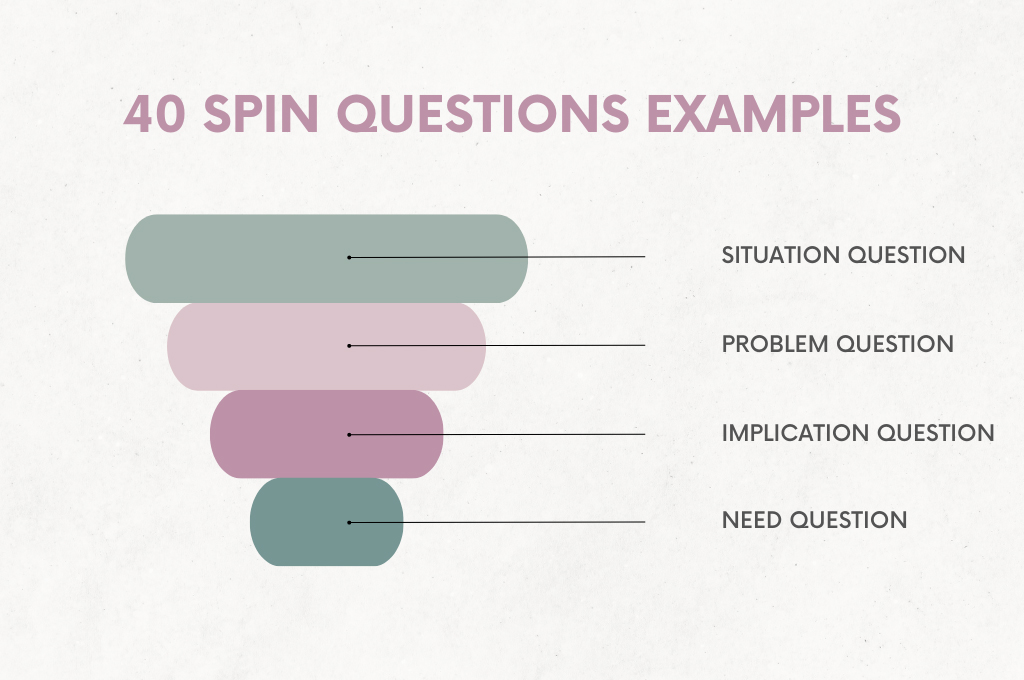40 SPIN Questions Examples

In the world of sales and customer engagement, asking the right questions is pivotal. It’s not just about what you ask, but how you ask it. This is where the SPIN questioning technique comes into play, a powerful tool for understanding and influencing potential customers.
What Are SPIN Questions?
SPIN questions are a strategic sales technique developed to better understand a prospective client’s needs and tailor solutions effectively. This approach divides questions into four categories, each serving a distinct purpose in the sales conversation.
Let’s explore what each category represents:
- Situation Questions aim to gather facts about the customer’s current situation. These questions help salespeople understand the context in which a potential solution might fit.
- Problem Questions are designed to identify specific problems, challenges, or pain points that the customer is experiencing. These questions help to uncover the areas where the customer might need assistance or improvement.
- Implication Questions delve deeper into the consequences or implications of the customer’s problems. They aim to highlight the urgency and importance of addressing these issues, making the need for a solution more apparent.
- Need-payoff Questions focus on the benefits and value of solving the customer’s problems. These questions encourage customers to think about the positive outcomes of finding a solution, thereby increasing their motivation to act.
Together, SPIN questions guide the conversation towards identifying and addressing the customer’s needs, leading to more effective and targeted sales pitches.
Situation Question Examples
Situation questions lay the groundwork in a sales conversation. They are designed to gather facts and background information. Think of them as the ‘setting the scene’ part of your sales dialogue. These questions help you understand where the customer is coming from, paving the way for more insightful discussions.
Here are 10 examples of situation questions:
- “Can you tell me more about your current process for managing inventory?”
- “How many employees work in your department?”
- “What type of technology are you currently using for this task?”
- “Could you describe the challenges you face during peak business hours?”
- “What systems are you using for customer relationship management?”
- “How has your company’s growth been over the past year?”
- “What does your typical project timeline look like?”
- “Can you walk me through your daily workflow?”
- “What kind of tools are your team currently working with?”
- “How does the decision-making process work in your organization?”
Problem Question Examples
After establishing the situation, the next step is to delve into problem questions. These questions help you and the customer identify and verbalize specific challenges they are facing. By pinpointing problems, you can later position your product or service as a solution.
Here are 10 examples of problem questions:
- “Do you find it challenging to maintain accurate inventory levels?”
- “Have you encountered any issues with your current software?”
- “Are you experiencing bottlenecks in your production process?”
- “Do you face difficulties in tracking customer interactions?”
- “Has your team mentioned any frustrations with their current tools?”
- “Are there any aspects of your service delivery that you’re unhappy with?”
- “Do you find data collection to be a time-consuming process?”
- “Have you faced challenges in meeting project deadlines?”
- “Are there any compliance or regulatory challenges you’re currently facing?”
- “Is maintaining customer satisfaction an issue with your current system?”
Implication Question Examples
Implication questions delve deeper into the consequences of the problems identified. They make the customer think about the impact of these problems on their business. This type of questioning amplifies the problem’s significance, setting the stage for offering a solution.
Here are 10 examples of implication questions:
- “How do these inventory inaccuracies affect your delivery times?”
- “What is the impact of software issues on your team’s productivity?”
- “How do bottlenecks in production affect your bottom line?”
- “What are the consequences of not tracking customer interactions effectively?”
- “How do your team’s frustrations with tools impact their work quality?”
- “What are the risks of continuing with your current service delivery model?”
- “How does the time spent on data collection affect your operational efficiency?”
- “What is the cost of missing project deadlines to your business?”
- “How might compliance challenges affect your company’s reputation?”
- “What are the implications of customer dissatisfaction on your sales?”
Need Question Examples
Finally, need questions are aimed at getting the customer to articulate their need for a solution. These questions are designed to make the customer envision the benefits and value of solving their problems, ideally with what you’re offering.
Here are 10 examples of need questions:
- “Would improving inventory accuracy help streamline your delivery process?”
- “How beneficial would it be to have more reliable software?”
- “What value would you place on eliminating production bottlenecks?”
- “Is enhancing customer interaction tracking a priority for your business?”
- “How important is it for your team to have more effective tools?”
- “What would an improved service delivery model mean for your company?”
- “Could reducing time spent on data collection improve your team’s efficiency?”
- “How critical is meeting project deadlines to your business’s success?”
- “What importance do you place on addressing compliance issues?”
- “How would improving customer satisfaction impact your sales?”
Using These Example SPIN Questions
Understanding and utilizing SPIN questions can significantly enhance your sales conversations and customer interactions. By carefully structuring your questions around Situation, Problem, Implication, and Need, you can gain deeper insights into your customers’ needs, highlight the urgency and impact of their challenges, and guide them towards recognizing the value of your solution.
Remember, the art of asking the right questions at the right time can transform a casual conversation into a successful sales opportunity.






